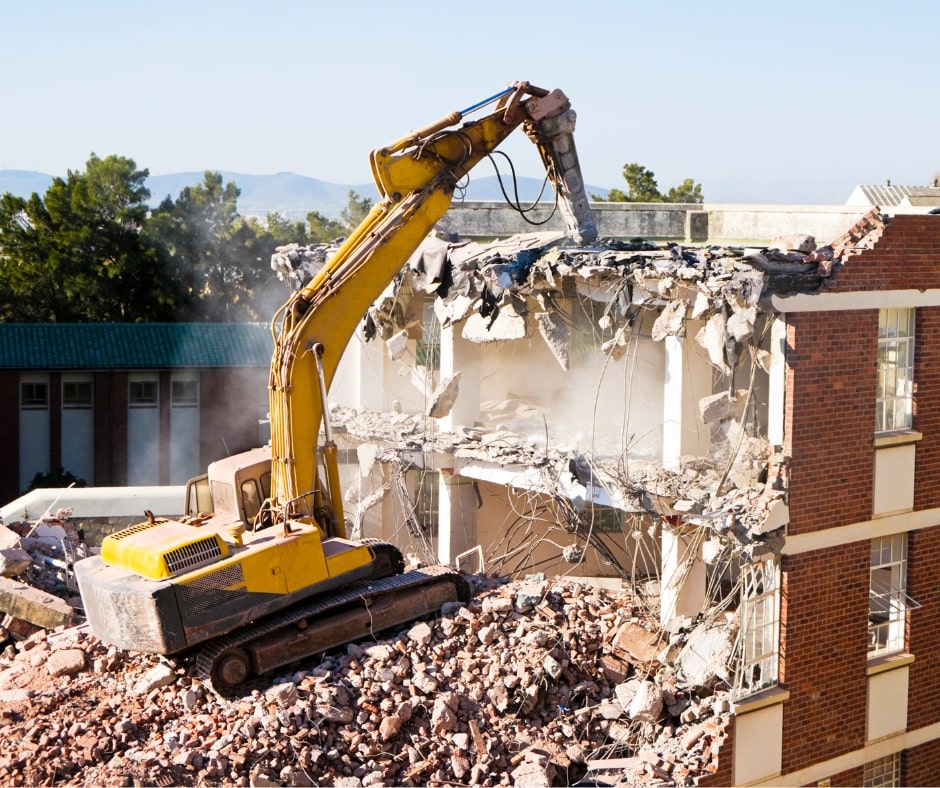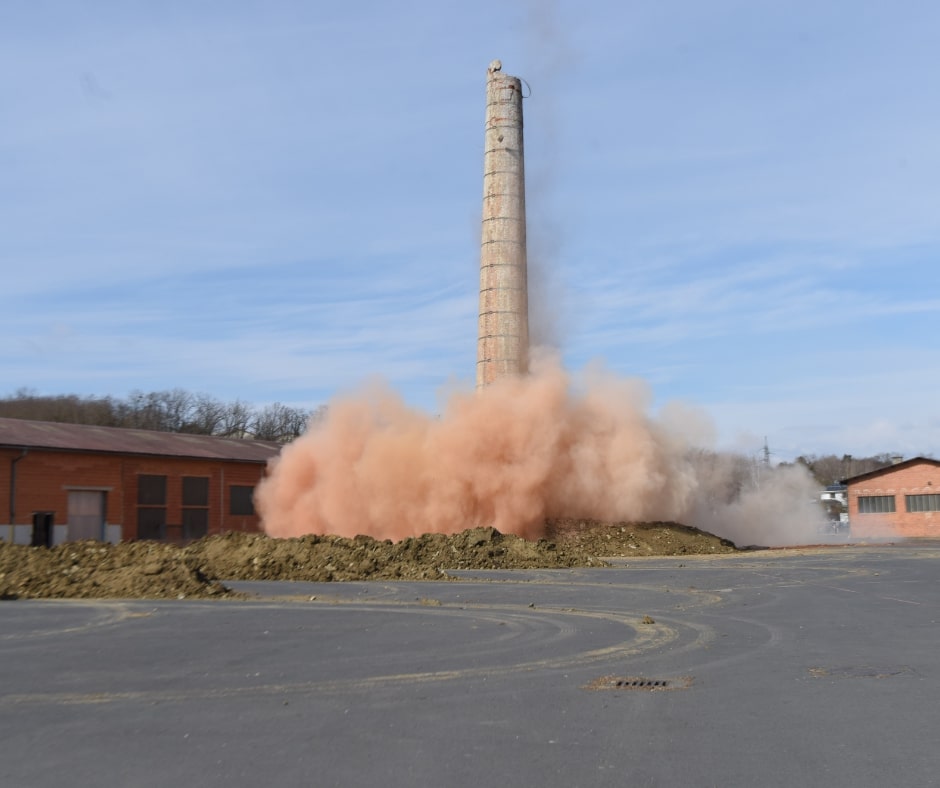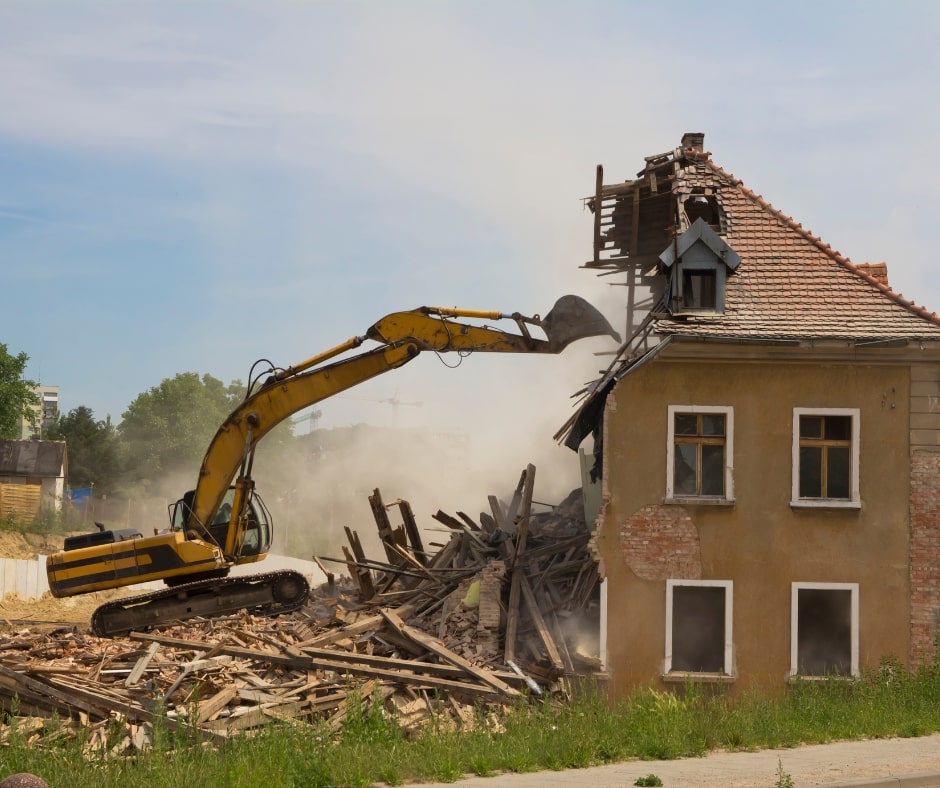“What goes up must come down”, this classic line helped Issac Newton explain gravity and is very relevant when discussing demolition. Demolition is often the most interesting and exciting part of construction, using explosives, wrecking balls, and huge machines to get rid of buildings.
There’s a lot more to demolition than just smashing a wrecking ball into a building or blowing a house to smithereens. In this guide, we’ll show you why we need demolition projects, how demolition work is planned, and some of the common methods of demolition. By the time you’ve finished reading, you’ll fully understand the entire demolition process.
Why is a waste management company writing a blog about demolition you ask. Well, demolition is one of the biggest contributors to solid waste in the UK, therefore, it is vital to have a proper waste management strategy in place during any demolition project.

A building being demolished using the dismantling method.
What is demolition?
Simply put, demolition is the process of dismantling a building or structure in a controlled and deliberate manner. A team of highly trained engineers and experts will put together a plan that takes into consideration all sorts of things from the buildings previous use to the weather to how far away the neighbours are. All buildings are different so the exact method will vary from project to project, but there are some key steps and techniques that stay the same.
Why do we need demolition?
You might want to demolish a building for a number of reasons, the most common one being that the building or structure is past its lifespan and is no longer structurally sound. Once it reaches this point it can become hazardous to anyone in the vicinity and needs to be removed.
Another reason for demolition is that you may want to replace a building that is no longer used with a structure that is needed, such as replacing a disused factory with a block of flats.
The two types of demolition.
Even though each demolition project is different and varies in complexity and scale, there are only two ways you’ll see a building demolished, implosion and dismantling.
Implosion.
This is the most dramatic technique you’ll see used in films and on TV. It involves using explosives to rapidly remove a building’s supporting structures, causing it to fall down. This method is highly technical and dangerous, so you’ll see it used less and less as demolition companies focus on more stable methods.
Implosion is used mainly on larger buildings and structures, such as factories and power stations. The building will be imploded in one of two ways, if there is enough space, explosives are fitted to the side of the building causing the building to topple over to one side once detonated. This method is referred to as falling like a tree. The other method, used when you don’t have a lot of space, is to fit the explosives centrally in the building, then once detonated the building collapses straight down. Buildings demolished this way are said to have fallen in its own footprint.

An industrial site being demolished via implosion.
Dismantling.
You are far more likely to see this demolition method used as it is much more controlled, it involves using machines such as wrecking balls, excavators, and other specialised machines to pull down structures a bit at a time. Excavators are fitted with specialist attachments such as a long reach arm to allow them to reach the top of tall buildings. This arm is usually fitted with a heavy-duty cutter that can chomp its way through concrete and even steel beams.
Demolition using high-reach excavators has grown in popularity as it is considered to be both cleaner and safer. It produces less flying debris, noise, and dust than the more high-impact methods of implosions or wrecking ball demolition. Other attachments used for demolition include hydraulic hammers, picks, and crushers.
A wrecking ball is the classic icon of demolition and is what probably springs to mind when you picture a demolition, it involves swinging a massive steel ball at high speed into the unsuspecting building. Usually, the ball is pulled back by a winch and released much like a pendulum but you can also use a spinning crane to generate movement.
Using a wrecking ball can be a cost-effective and fast way of demolishing buildings. There are a number of drawbacks you need to consider with a wrecking ball though, they create a lot of dust and flying debris, and you will find it difficult to control the ball’s trajectory once it pounds into the building. For these reasons you’ll find wrecking balls are becoming increasingly less common on demolition sites as contractors switch to the more controlled method of excavator demolition.

An excavator being used to demolish a house.
A typical project.
Now you’ve seen the different methods of demolition, let’s take a look at a typical demolition project, as you’ve already read, each project is different but there are some steps that are followed in nearly all demolition works.
Pre-demolition.
- Survey the building- This is where engineers and other experts will check everything about the building, including its design, the materials used, what the building was previously used for, and the nearby area. At this stage, you would also check for any hazardous materials such as asbestos or any flammables and assess the structural system of the building.
- Remove hazardous materials- If you find any hazardous materials during the initial survey then the next thing to do is remove them. This should be done by experts who are trained in the handling and disposal of hazardous waste. It’s important to complete this step before the demolition begins as it will be hard to separate the materials after, and more importantly, the act of demolition could spread any hazardous materials into the surrounding areas.
- Prepare the demolition plan- Demolition is a complex operation so you need to complete a plan to tackle a demolition project. This will include things such as what is happening when and in what order, who is responsible for each activity, and which demolition method will be used. Any plan will also need to include how Health and Safety and waste management will be managed on site.
- Implement safety measures- As you’ve read, demolition poses a lot of Health and Safety risks. To help keep everyone on site safe and in one piece safety measures must be in place before any work begins. This will include controlling access to site, erecting barriers and safety signs, making sure the right PPE is available, and having all the right permits completed before starting work.
Demolition phase.
Based on the outcome of the survey, the demolition method will have been chosen during the planning phase. Some projects will require a “soft strip” before the heavy machines roll in. This is basically where workers with hand tools will remove lighter items such as doors, wiring, fitted cupboards and other items from inside the building.
After this phase you’d expect the services such as the gas, electricity, and water to be disconnected from the building, this is usually done by the utility companies that supply those services. The reason for doing this before you start knocking things down is once you start tearing out walls you will rupture water pipes, expose cables, etc. which would be dangerous if there is still power, or water supplied.
An engineer surveying the demolition plans.
Once you’ve taken all the lighter items out of the building and disconnected the services the fun part can begin! If the building is being dropped by implosion, then the explosive charges need to be prepared and the area where the building will fall needs to be cleared.
If you are dismantling the building, then now is the time to bring the cavalry in! The machines that have been selected during the planning stage will arrive on site and start tearing the building down bit by bit. During this phase it’s important that the waste generated is managed correctly, a variety of grab lorries, tippers, and skips will be used to transfer the material away as it is removed from the structures.
The clean-up.
Clearly demolishing a building creates a lot of mess. Aside from the obvious rubble and concrete, there is also likely to be a large quantity of other materials such as metal, plastic, and wood. All this must be removed from site once the demolition is complete so that the area can be handed over in a safe state.
As previously mentioned, if a building is demolished by using excavators, the material removed will most likely be taken away from site or stored away somewhere in a skip to keep the work area tidy. If the building is demolished using explosives, then all the material needs to be collected and moved away from site.
A fully loaded RORO skip.
This will be done using a variety of machines such as bulldozers, excavators, loading shovels, and grab lorries to load tipping trucks that take the material away to waste transfer stations ready for recycling. Most of the time the materials will be grouped together on the demolition site as it is more cost-effective to take one material type at a time to the waste transfer station.
Once all the materials from the demolition are removed, the area can be handed over and the next phase can begin, usually, you will find something new built in the building’s place, whether this be new buildings or an outdoor area such as a playground or park.
Thank you for reading this guide on demolition, hopefully you understand the process a bit better now and are clear on how everything works. If you want to find out more about demolition, click on the further reading and sources below. Some of the links have cool diagrams showing the different stages of demolition and have free tools such as checklists so make sure you check them out. As always if you want to discuss any aspect of demolition or waste management, you can email the team here, we love talking rubbish!
